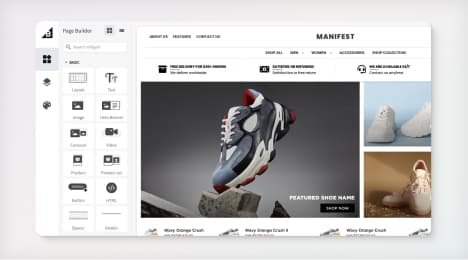
Watch Our Product Tour
See how BigCommerce helps you build and manage your online store with ease.
- Ecommerce Insights

6 Key Steps to Launch Your Online Store
Explore our Launch Foundations series to get your BigCommerce store up and running quickly.
BigCommerce helps growing businesses, enterprise brands, and everything in-between sell more online.
Product guides and their features
Online product guides categorize and describe all of the items sold on an ecommerce site. Often called online catalogs, these resources provide simple navigation on ecommerce store websites. They provide shoppers with any and all information needed in order to make a solid purchasing decision.
There are many ways to display effective product guides on an ecommerce site. Strong, clear organization and navigability eliminate consumer confusion, increase usability and lead to higher sales. Customer decision-making is highly influenced by these online catalogs. Guides and catalog listings are the No. 1 tool used by shoppers when browsing product options and making choices.
From the ecommerce store's homepage, and every landing page on the site, ensure navigability to the product guide page. Separate all products into categories that clearly establish what the user will find should they click on that category's listing. For example, clothing ecommerce sites list products by type with terms like "pants," "shirts," "jackets" and "athletic wear." Each group gets its own unique landing page with a listing of all products that fall into it. Getting to a desired category page in no more than two clicks is ideal. If necessary, use graphics or illustrated images to further differentiate between categories.
How to develop effective guides
There are three keys to building effective product guides:
Language - Use language to name different products that reflects the consumer's mentality, not terms and phrases that highlight buzzwords used internally at the ecommerce store facility. Simplicity is most effective when it comes to vocabulary and fonts. Over-selling a product with grandiose language will alienate consumers.
Descriptions - Describe each product in as much detail and with as little language as possible. Concise descriptions are more effective. Include the size, material and purpose of each item. Include information on shipping and handling. Propose additional items that the buyer may also be interested in at the bottom of the page.
Photos - Images are the most important element of an ecommerce store's online product guide. Since online shoppers cannot verify product size, texture and quality in person, they rely heavily on photographs to convey all the necessary details to their senses. High-quality images bridge the gap between doubt and trust. Consumers are more inclined to make a purchase from a site with effective photography than one with low-definition pictures, or none at all. Provide multiple angles of each product so consumers can see exactly what they are buying. If an item is available in multiple colors or patterns, include all options, each with their own photo. Consistency is incredibly important for maintaining a cohesive brand image. All products should appear in the same lighting, with the same background and at a similar or identical distance from the camera.
Customization within the product guide
Once a customer has reached their desired product page, ecommerce store owners must provide options for customization.
Dropdown lists - If a particular product is offered in multiple sizes, colors or quantities, dropdown lists allow shoppers to compare different options and choose their favorite from a list easily. This feature also saves space on the ecommerce site; rather than listing the same style shirt in 7 different colors, all 7 colors are listed in the same location.
Checkboxes - Checkboxes work well for sites with highly customizable orders. They allow customers to add or remove features before ordering their product.
On the checkout page, link each item in a consumer's shopping cart back to its landing page in the product guide. This provides a convenient method of double-checking orders and reduces the amount of returns ecommerce owners receive.
BigCommerce helps growing businesses, enterprise brands, and everything in-between sell more online.
Start growing your ecommerce business even faster.
High-volume or established business? Request a demo